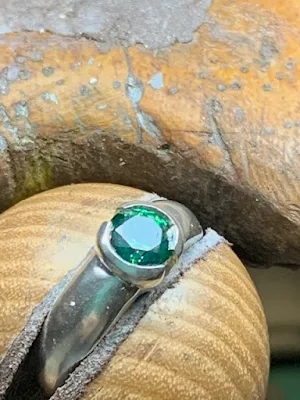As this one essay was printed in 2017, it still needs to be written into this blog in 2023. Instead of using "Lewy" I'll be using "my" or "I" as needed.
=================================================
I have dedicated my life to perfecting the art of setting stones. And through my studies, I've learned the importance of having a nice, clean edge on my settings and the right tools needed to achieve that.
In my practice, I rely upon a series of gravers to do my cutting work, with some modifications. "Tool suppliers sell good gravers, but they are so very thick".
In order for them to be suitable for my cutting work, I need to greatly modify them.
I start with a standard #1 (or #2) Onglette graver and start the shaping process with my bench grinder. Because of the amount of metal, I must remove an estimated 50% of the front of the graver metal that is to be greatly modified. I will grind away metal from the tip (or front) of the graver.
When the graver looks sufficiently shaped, I will use my oilstone to refine the cutting edge and also any sharp & rough edges. If this blade is still too wide, I'll take it back to my bench grinder to refine the cutting point more.
I will spend about 50% of my time working on the bench grinder and an additional 50% on my oilstone, making subtle changes and watching my new graver angles. This process will take me about 20-30 minutes nonstop. If needed, I will keep going from my bench grinder to my oilstone repeatedly. I WANT ONLY PERFECTION.
This graver is akin to a 'razor blade' as only the front of this graver will come into contact with the metal or stone.
Once I'm satisfied with the shape of this new graver it will be used for Bright-Cutting along Channel Settings, Pave Settings & Gypsy Setting walls.
After every two or three cuts into the metal, I will stop and refurbish the front of the graver. As noted, I WANT AND DEMAND A SURGICAL INSTRUMENT.
==================================================
Tool Suppliers can't make these specialized tools, only Diamond Setters have that technique.
(I remember once that a jewellery store owner requested that I travel down to his store from Toronto to Tennessee to help him. I looked at his gravers and not one of them was put to his bench grinder, why? He hadn't bought one).
Here are 14 recently archived photographs with explanations that I'll be using for this informative essay.
----------------------------------------------------------------------------------
On the left is my untouched graver along with 9 gravers for various cutting needs.
I use this particular graver company for their 'high-speed steel' metal.
Here is my bench grinder for all of my graver-shaping.
In this photo, I'm removing any unused section of the graver that goes into my adjustable & extended handle.
I prefer the 2 screw handle, why? In case one screw gets ruined I still the remaining screw to keep it usable.
As you can see my graver blade has been greatly modified for my metal cutting.
In my collection of tools, I have 12 handles each with its own gravers.
This is my oilstone that I keep within reach of my left hand and it is continually kept moist with a 'light viscous' oil.
Here is the 'before & after' width of my cutting blade.
Here are my assortment of Emery & Polishing papers. These keep my gravers in pristine cutting condition. The grits range from #240 Emery to #1,200 Polishing.
This "Right-Sided Onglette" graver is very important in my "Bright-Cutting" in this Bezel setting.
This particular #600 (Polishing grit) is the first of many 8 stages in paper-polishing a graver.

This photo shows how a modified "Right-Sided" graver should look for metal cutting. BTW, only the "right side" is highly polished, (if you are right-handed.
I hope that this essay was helpful to you.












.jpg)
.jpg)
.jpg)
.jpg)
.jpg)
.jpg)
.jpg)

.jpg)











.jpg)

.jpg)


.jpg)



.jpg)


